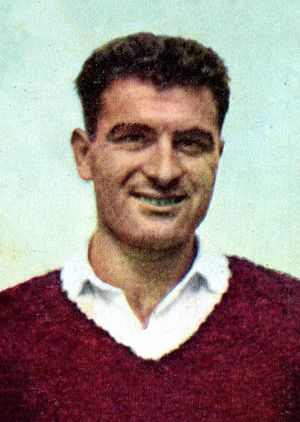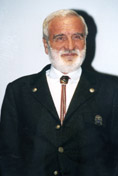Cesare Maestri facts for kids
| Personal information | |
|---|---|
| Nationality | Italian |
| Born | 2 October 1929 Trento, Trentino, Italy |
| Died | 19 January 2021 |
| Climbing career | |
| Type of climber | Mountaineer |
| Known for | "Spider of the Dolomites" |
Cesare Maestri (born October 2, 1929 – died January 19, 2021) was a famous Italian mountaineer and writer. He was born in Trento, Italy.
Maestri started climbing in the Dolomites, a mountain range in Italy. He became known for climbing many difficult routes by himself (called solo) and without using ropes or gear to pull himself up (called free). He also created many new, very hard climbing paths. Because of his amazing skills, people called him the "Spider of the Dolomites." In 1952, he became a professional alpine guide. Some of his impressive solo climbs include routes on Civetta, the Marmolada, and the southwest ridge of the Matterhorn in winter.
Contents
Cerro Torre: A Mountain of Challenges
The 1959 Expedition
In 1959, Maestri traveled to Patagonia with his friends Cesarino Fava and Toni Egger. Their goal was to climb the north-east ridge of Cerro Torre. This mountain was known for being extremely difficult and had never been fully climbed before.
The three climbers started their ascent. Fava turned back at a certain point. Maestri later said that he and Egger continued and reached the summit. On their way down, Maestri claimed that Egger was swept away by an avalanche and died. Six days later, Fava found Maestri almost buried in the snow. They returned to base camp.
Doubts About the 1959 Climb
Over the years, many famous climbers began to doubt Maestri's story about reaching the summit in 1959. They pointed out how incredibly hard the route was. Even with better climbing tools invented later, it was still very tough.
Climbers like Reinhold Messner and Ermanno Salvaterra were among those who had doubts. They noted that Maestri's description of the climb was very detailed for the lower parts. But for the higher sections, it became vague and hard to follow on the mountain. Also, climbing equipment like bolts and ropes were found on the lower parts of the route. However, none were found on the higher sections where Maestri claimed to have climbed. Despite these doubts, Maestri always stuck to his story, as did Fava.
The Controversial Compressor Route
In 1970, Maestri returned to Cerro Torre. This time, he climbed a new route on the mountain's southeast side. He used a special machine called a petrol-driven air compressor. This machine weighed about 135 kilograms (300 pounds). He used it to drill about 400 bolts into the rock. He also placed thousands of meters of fixed ropes. This new path became known as the Compressor Route. The compressor machine itself can still be seen hanging on the mountain, about 100 meters below the top. Maestri stopped just before the very highest point, which is often covered by an "ice mushroom."
The Compressor Route caused a lot of debate among climbers. While using a few bolts for safety was accepted, using a mechanical compressor and so many bolts was seen as too much. Many felt it took away the challenge and spirit of climbing. Some even called it "A Mountain Desecrated."
Later Ascents and Changes
The first climb of Cerro Torre that everyone agreed on happened in 1974. It was done by Casimiro Ferrari, Daniele Chiappa, Mario Conti, and Pino Negri. They also climbed the "ice mushroom" at the very top.
In 1991, a movie called Scream of Stone was made. It was a story based on the climbs of Cerro Torre by Cesare Maestri.
In 2012, two climbers, Hayden Kennedy and Jason Kruk, made a new ascent of the southeast ridge. They tried to climb it using "fair means," meaning they used very few of Maestri's bolts. On their way down, they removed about 120 bolts from the Compressor Route. They wanted to make the climb challenging again, as it was originally.
Soon after, in 2012, David Lama and Peter Ortner made the first free ascent of the southeast ridge. This meant they climbed the route without pulling on any bolts for help. Lama said it was the greatest adventure of his life.
In 2015, some researchers showed that a photo Maestri claimed was taken on the summit of Cerro Torre was actually taken on a different peak nearby called Perfil de Indio.
See also
 In Spanish: Cesare Maestri para niños
In Spanish: Cesare Maestri para niños



